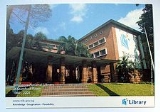
Old National Library Building
Encyclopedia
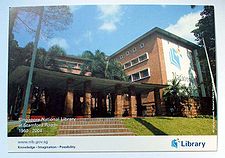
Stamford Road
Stamford Road is a one-way road in Singapore within the planning areas of Downtown Core and Museum. The road continues after the traffic light junction of Nicoll Highway, Esplanade Drive and Raffles Avenue towards Orchard Road. It then ends at the junction of Fort Canning Road, Bencoolen Street...
in the Museum Planning Area
Museum Planning Area
The Museum Planning Area is an urban planning area in the Central Region of Singapore. It is located in the area known as the Civic District. The area plays a "bridging role" between the Orchard Street area and the Downtown Core, which necessitates proper transport networks for vehicles,...
of Singapore
Singapore
Singapore , officially the Republic of Singapore, is a Southeast Asian city-state off the southern tip of the Malay Peninsula, north of the equator. An island country made up of 63 islands, it is separated from Malaysia by the Straits of Johor to its north and from Indonesia's Riau Islands by the...
. Originally completed in 1960, it housed the National Library
National Library, Singapore
The National Library in Singapore is located on an 11,304-square metre site between Bugis Junction and the Bras Basah Complex at 100, Victoria Street...
and was a national icon for many Singaporeans. Despite a huge groundswell of public dissent, the library was closed on 31 March 2004, and was demolished to make way for the construction of the Fort Canning Tunnel
Fort Canning Tunnel
Fort Canning Tunnel , abbreviated as FCT, is a vehicular tunnel in the Central Area of Singapore.Besides the utilization of relatively new engineering techniques, special care was taken to minimize impact on the environment of the surrounding Fort Canning during construction...
to ease road traffic to the city. The controversy surrounding the building's demise has been credited for sparking greater awareness of local cultural roots and an unprecedented wave in favour of heritage conservation among Singaporeans.
History
The Singapore National LibraryNational Library, Singapore
The National Library in Singapore is located on an 11,304-square metre site between Bugis Junction and the Bras Basah Complex at 100, Victoria Street...
traces its roots to Sir Stamford Raffles
Stamford Raffles
Sir Thomas Stamford Bingley Raffles, FRS was a British statesman, best known for his founding of the city of Singapore . He is often described as the "Father of Singapore"...
, the founder of modern Singapore, who in 1823 started a small private collection of books housed in the Raffles Institution
Raffles Institution
Raffles Institution , founded in 1823, is the oldest centre for pre-tertiary learning in Singapore. It is an independent school in Singapore providing secondary and pre-university education. RI consists of a boys-only secondary section , and a coeducational pre-university section...
. This was known as Raffles Library, and access to the collection was limited to the British and privileged class. Dr. Robert Morrison, an eminent missionary and educator became the first librarian
Librarian
A librarian is an information professional trained in library and information science, which is the organization and management of information services or materials for those with information needs...
from 1823 to 1845. He was mainly responsible for establishing the plans with Raffles and soliciting book donations for the Library.
World War II
The Raffles Library was converted into a Regimental Aid Station by the British and Australian army during the JapaneseEmpire of Japan
The Empire of Japan is the name of the state of Japan that existed from the Meiji Restoration on 3 January 1868 to the enactment of the post-World War II Constitution of...
invasion in February 1942. The Library building suffered damages on its northwestern wall and rooftop during the invasion. After the British surrender of Singapore on 15 February 1942, the Library was taken over by the Japanese and renamed the during the Japanese Occupation
Japanese Occupation of Singapore
The Japanese occupation of Singapore in World War II occurred between about 1942 and 1945 after the fall of Singapore on 15 February 1942. Military forces of the Empire of Japan occupied Singapore after defeating the combined Australian, British, Indian and Malayan garrison in the Battle of Singapore...
. On 29 April 1942, it reopened to the public on the occasion of the birthday of the Emperor of Japan, Hirohito
Hirohito
, posthumously in Japan officially called Emperor Shōwa or , was the 124th Emperor of Japan according to the traditional order, reigning from December 25, 1926, until his death in 1989. Although better known outside of Japan by his personal name Hirohito, in Japan he is now referred to...
(裕仁). Shōnan Toshokan was headed by Marquis
Marquis
Marquis is a French and Scottish title of nobility. The English equivalent is Marquess, while in German, it is Markgraf.It may also refer to:Persons:...
Yoshichika Tokugawa as its President, a relative of the Japanese Emperor.
On 18 February 1942, E.J.H. Corner, the assistant Director of Gardens in the Straits Settlement, with the support of Sir Shenton Thomas
Shenton Thomas
Sir Thomas Shenton Whitelegge Thomas, GCMG, GCStJ was the last Governor of the Straits Settlements, 1934–1942 during which time World War II began. He died at age 82...
, met a group of Japanese scientists and nobles with the intention of protecting the invaluable collections of the Library and museum. He was later enlisted by Professor
Professor
A professor is a scholarly teacher; the precise meaning of the term varies by country. Literally, professor derives from Latin as a "person who professes" being usually an expert in arts or sciences; a teacher of high rank...
Hidezo Tanakadate to assist in re-establishing the library and museum. To increase its collection, abandoned books and journals were collected from all across the states of Malaya
British Malaya
British Malaya loosely described a set of states on the Malay Peninsula and the Island of Singapore that were brought under British control between the 18th and the 20th centuries...
and deposited at the Library.
The Library was patronised mainly by the Japanese and captured European
European ethnic groups
The ethnic groups in Europe are the various ethnic groups that reside in the nations of Europe. European ethnology is the field of anthropology focusing on Europe....
staff from the Department of Information, who created propaganda for the Japanese invasion of India and Australia. More than 13,000 volumes were also circulated to civil internees at the Maxwell Road Customs House and prisoners-of-war at Changi Prison
Changi Prison
Changi Prison is a prison located in Changi in the eastern part of Singapore.-First prison and POW camp:...
. Among these volumes were prayer books, hymnals, music sheets and children's books.
Post-war
After the Japanese surrender in September 1945, Lieutenant-Colonel G. Archey of the British Military Administration took over Directorship of the Library and museum on September 6. The Library only suffered minimal losses and damages during the three and a half years of Japanese Occupation, as the Japanese preserved the Library well due to its respected reputation in academia. Compared to other libraries in Malaya which lost nearly half of their collections, only some 500 reference books were looted according to a stocktake done after the war.In the 1950s, public demand mounted for a free public library to meet the needs of all levels of society. Lee Kong Chian
Lee Kong Chian
Lee Kong Chian , was a prominent businessman and philanthropist and the founder of The Lee Foundation in Singapore. He was one of Southeast Asia's richest men in the 1950s and 1960s. He was the son-in-law of philanthropist Tan Kah Kee.-Early life:...
, a renowned Chinese community leader and philanthropist, offered S$350,000 in 1953 towards the founding of the first free public library in Singapore on condition that vernacular languages were promoted and encouraged in the public arena. The British government accepted the offer without hesitation and began demolishing the old St Andrew's Chapel and the British Council
British Council
The British Council is a United Kingdom-based organisation specialising in international educational and cultural opportunities. It is registered as a charity both in England and Wales, and in Scotland...
Hall sited at the foot of Fort Canning Hill along Stamford Road to make way for the new library. The chosen site was situated among many civic and educational institutions on or around Fort Canning Hill and the nearby Bras Basah area. Lee later laid the foundation stone that reads:
50 years later, on 15 September 2003, his son Dr. Lee Seng Gee repeated history when the Lee Foundation
Lee Foundation
Lee Foundation is a charitable foundation in Singapore created to aid "the advancement of education, medicine and cultural activities; helping the poor; and assisting victims of fire, flood and famine", It also funded other philanthropic work...
he chaired gave S$60 million to the National Library Board, the largest single corporate donation ever in Singapore. In July 2005, the new National Reference Library at Victoria Street was named Lee Kong Chian Library in his father's honor.
New building
Designed and built by the Public Works Department, the new red-bricked building was officially opened and christened as the National Library on 12 November 1960 by the President of SingaporePresident of Singapore
The President of the Republic of Singapore is Singapore's head of state. In a Westminster parliamentary system, as which Singapore governs itself, the prime minister is the head of the government while the position of president is largely ceremonial. Before 1993, the President of Singapore was...
, Encik Yusof bin Ishak. The architecture was said to reflect the red-brick epoch of British architecture in the 1950s. Hedwig Anuar was appointed the first Singaporean Director of the National Library in April 1960 and served until June 1961. Aside from its extensive English collection, the library also made Chinese, Malay
Malay language
Malay is a major language of the Austronesian family. It is the official language of Malaysia , Indonesia , Brunei and Singapore...
and Tamil
Tamil language
Tamil is a Dravidian language spoken predominantly by Tamil people of the Indian subcontinent. It has official status in the Indian state of Tamil Nadu and in the Indian union territory of Pondicherry. Tamil is also an official language of Sri Lanka and Singapore...
books available for loan. Occupying a total floor area of 10,242 square metres, the library consisted of:
- A reference library
- Reading sections for adults and children
- A lecture hall
- A five-storey stack for reference and research materials
- South East Asian Room
- A microfilm unit
To cultivate reading habits among the young, the Library initiated many activities such as story-telling sessions for children and talks for teenagers, conducted by the staff or members of the public. Among adults, the Library also promoted books written by local writers, publishing a bibliography
Bibliography
Bibliography , as a practice, is the academic study of books as physical, cultural objects; in this sense, it is also known as bibliology...
of their writings and encouraging Singaporeans to read local literature in all languages. Such activities are still being carried out by the National Library Board to the present day.
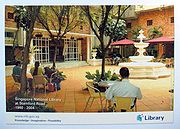
Raffles Institution
Raffles Institution , founded in 1823, is the oldest centre for pre-tertiary learning in Singapore. It is an independent school in Singapore providing secondary and pre-university education. RI consists of a boys-only secondary section , and a coeducational pre-university section...
, Raffles Girls' School, St Joseph's Institution and Tao Nan School
Tao Nan School
Tao Nan School , is a co-educational primary school in Singapore. One of the five Singapore Hokkien Huay Kuan schools, along with Ai Tong School, Chongfu Primary School, Kong Hwa School and Nan Chiau Secondary School, Tao Nan School is among the 30 most popular primary schools listed by the...
that had their early beginnings in this area. The landmark Balustrade or front porch and steps leading up to the Library became an intimate public space where one could sit and read, wait, chat or simply watch the world go by.
The Courtyard Cafe and The Fountain located within the Library had also became an institution, well-patronised by library users, office workers and the local arts community from The Substation
The Substation
The Substation is Singapore's first and only independent contemporary arts centre. It was founded in 1990 by Kuo Pao Kun.The Substation is centrally located in the city's civic district. Venues at The Substation for hire include a black-box theatre, a gallery, a dance studio, the Random Room and...
. As such, many fond memories were created for those who visited the compounds of the Library. At the same time, the pressure of urban redevelopment in the city was building up, resulting in demolishing of old city fabric that would threaten the Library building's fate and its sentimental memories in the ensuing years.
Civic and Cultural District Master Plan
A Civic and Cultural District Master Plan Exhibition was held in April 1988 by the Ministry of National Development (MND) to garner public feedback to develop the Central area into a historical, cultural and retail zone. The 1988 Master Plan was aimed to revitalise Singapore's civic and cultural hub, citing the location of key cultural institutions such as the Victoria Theatre and Concert HallVictoria Theatre and Concert Hall
The Victoria Theatre and Concert Hall is a complex of two buildings and a clock tower joined together by a common corridor and is located in the civic district of Singapore...
, the National Museum
National Museum of Singapore
The National Museum of Singapore is a national museum in Singapore and the oldest museum in Singapore. Its history dates back to 1849 when it was started as a section of a library at Singapore Institution...
, as well as the National Library within the District.
On May 28, the MND Minister
Minister (government)
A minister is a politician who holds significant public office in a national or regional government. Senior ministers are members of the cabinet....
, S. Dhanabalan chaired a dialogue attended predominantly by invited professionals such as planners, architects and property consultants to review the Master Plan exhibited a month earlier. During the professional dialogue, the Urban Redevelopment Authority
Urban Redevelopment Authority
The Urban Redevelopment Authority is the national urban planning authority of Singapore, and a statutory board under the Ministry of National Development of the Singapore Government.-Mission:The authority was established on 1 April 1974, and is of especially critical importance to the city-state,...
's (URA) many microplanning proposals were reviewed, including the proposed demolition of the National Library to create a "clear view of Fort Canning Hill from Bras Basah Park". No conclusive statement on the building's fate was made in the press report or in URA's publication, Skyline Vol. 35/88 (Jul/Aug 1988).
New national library
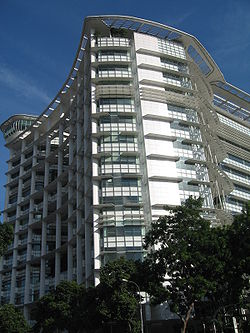
Parliament of Singapore
The Parliament of the Republic of Singapore and the President jointly make up the legislature of Singapore. Parliament is unicameral and is made up of Members of Parliament who are elected, as well as Non-constituency Members of Parliament and Nominated Members of Parliament who are appointed...
to build a new National Library and four new branches in Yishun
Yishun
Yishun, or Nee Soon as it was initially named, is a suburban town in the northern part of Singapore, encompassing the Yishun Planning Area, in the North Region, which includes Yishun New Town and the Nee Soon private residential estate....
, Tampines
Tampines
Tampines is the largest residential area in the city-state of Singapore and is located in the East Region of the main island. The town is so named because in the 1900s a large forest of Tampines trees were there....
, Hougang
Hougang
Hougang is an urban planning area and a suburb in the north-eastern area of the city-state of Singapore. Under classification by the Urban Redevelopment Authority, the area is part of the North-East Region, an urban planning division. Hougang borders Sengkang in the north and Serangoon to its...
and Woodlands
Woodlands, Singapore
Woodlands, or the Woodlands New Town , is a suburban town in northern Singapore, part of the North West Community Development Council district...
. This announcement generated extensive discussion in the ensuing months on the potential of a new National Library. On 17 March 1990, the Ministry of Community Development confirmed in Parliament that the new National Library would be sited at the former Raffles Girls' School site in Queen Street. A library consultant was appointed the following month to advise on the planning of the new building.
Revision in plan
The 1992 Civic District Master Plan public exhibition was held from February 22–26 by the URA. An important revision was the mentioning of the one-way Fort Canning Tunnel, entering the hill at the existing National Library and emerging at Penang Road to be built by the year 2000. The URA explained that the 380m long tunnel would fulfilled 2 main functions:- To direct heavy traffic away from MarinaMarina SouthMarina South is a peninsula adjacent to the Central Business District in Singapore, and also the name of an urban planning area in the Central Area of Singapore's Central Region.-History:...
to OrchardOrchard RoadOrchard Road is a road in Singapore that is the retail and entertainment hub of the city-state. It is regularly frequented by the local population as well as being a major tourist attraction...
areas so as to give the museum precinct a peaceful and quiet ambience - To smoothen the major traffic intersection in front of Cathay BuildingCathay BuildingThe Cathay Building was opened in 1939 by Dato Loke Wan Tho as the headquarters for the British Malaya Broadcasting Corporation...
Work on the tunnel was expected to start after the National Library is relocated to Victoria Street
Victoria Street, Singapore
Victoria Street [Tamil]: விக்டோரியா ஸ்திரீட் is a street located in the Central Area of Singapore. The street starts at Victoria Bridge at the end of Kallang Road, after the Immigration and Checkpoints Authority building, in the north and continues as Hill Street at its junction with Stamford Road...
by 1996. In the extensive press reports in 1992, neither the demolition of the National Library building nor the reasons for changing the site of the new National Library to Victoria Street were given.
In the subsequent 1997 Master Plan for the area, plans for the Fort Canning Tunnel remained unchanged and it was not explicitly stated in the report that the National Library building would be demolished. In April 1997, the Library was closed for a S$2.6 million upgrading and renovation programme to meet the needs of the IT age. When it reopened on Oct 1, its facilities were upgraded and highly computerised. Its collection was updated and 80,000 volumes were added.
'National Library to go'
On 8 December 1998, a letter by Kelvin Wang to the Straits Times ForumThe Straits Times
The Straits Times is an English language daily broadsheet newspaper based in Singapore currently owned by Singapore Press Holdings . It is the country's highest-selling paper, with a current daily circulation of nearly 400,000...
page triggered a string of events that would bring the normally passive Singaporeans to display rare sparks of civic activism. Kelvin brought to the public attention that there was a possibility that the National Library would be demolished, after a recent announcement by the newly formed Singapore Management University
Singapore Management University
The Singapore Management University was officially incorporated on January 12, 2000, and was Singapore's first private university funded by the government...
(SMU) that its new city campus would be sited in the Bras Basah area including the National Library's present site. Kelvin wrote:
In response, the SMU assured the public that they could play a part in deciding the fate of the red-bricked building housing the National Library, as it had not decided what to do with the building. On 13 March 1999, SMU organised a public symposium
Symposium
In ancient Greece, the symposium was a drinking party. Literary works that describe or take place at a symposium include two Socratic dialogues, Plato's Symposium and Xenophon's Symposium, as well as a number of Greek poems such as the elegies of Theognis of Megara...
at the Singapore Art Museum
Singapore Art Museum
The Singapore Art Museum contains the national art collection of Singapore. It has a collection of 7,750 pieces of Singaporean and Southeast Asian modern and contemporary art, and has an expanding collection of new Asian and international contemporary art.- History :Officially opened in 1996, it...
(former St Joseph's Institution) to gather feedback for its campus masterplan. Overwhelming turnout and passionate debate amongst the audience marked this highly publicised event, which lasted over 4 hours. This was the first occasion where URA made public their definitive decision to demolish the National Library building as "it was not of great architectural merit and should not be conserved."
Public dissent
From March to April 1999, there arose a huge groundswell of public dissent in the media over the National Library building's fate, as well as the drastic physical alterations of its environs. A number of featured columns by journalists touched on gradually disappearing heritage landmarks, as well as shared memories of Singaporeans.On 24 January 2000, after SMU chaired a technical workshop to obtain feedback on three alternative proposals, a well-known architect named Tay Kheng Soon held a press conference at The Substation to unveil his unofficial SMU masterplan. URA was invited to the presentation but did not show up. His proposal entailed re-routing the tunnel in order to save the National Library building. A week later, Tay wrote to the Prime Minister's Office
Prime Minister of Singapore
The Prime Minister of the Republic of Singapore is the head of the government of the Republic of Singapore. The President of Singapore appoints as Prime Minister a Member of Parliament who, in his opinion, is most likely to command the confidence of a majority of MPs.The office of Prime Minister...
regarding his proposal which was referred to the MND. Many members of the public wrote in publicly either in support of Tay's plans or argue for heritage conservation in general. A few articles and letters highlighted that the adamant official response to public dissent ran counter to the spirit of the Government's S21 Vision, which expressed a desire to foster civic participation and active citizenry.
On 7 March 2000, the Minister for National Development, Mah Bow Tan
Mah Bow Tan
Mah Bow Tan is a politician from Singapore. A member of the governing People's Action Party , he is currently a Member of Parliament representing the Tampines Group Representation Constituency...
, announced in Parliament that the National Library building would have to go. According to Mah, the authorities had assessed Tay's plans but concluded that the URA's plan was a better proposal for preserving the Civic District's ambience and being more people-friendly. With no choice, the public and activists accepted the final decision to demolish their beloved Library and the debates slowly frizzled off.
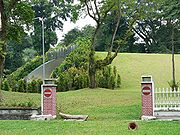
Aftermath
The old National Library was eventually torn down in 2005. Today, all that remains of the building at its original site are two red-bricked entrance pillars standing near the Fort Canning Tunnel. The controversy surrounding the building's demise has been credited for sparking greater awareness of local cultural roots and an unprecedented wave in favour of heritage conservation among Singaporeans.The new National Library at Victoria Street was completed on July 2005. In memory of the old National Library building, about 5,000 red bricks were salvaged from the old Library and used to construct a commemorative wall in a bamboo garden located within the new building.
See also
- National Library, SingaporeNational Library, SingaporeThe National Library in Singapore is located on an 11,304-square metre site between Bugis Junction and the Bras Basah Complex at 100, Victoria Street...
- Singapore National TheatreSingapore National TheatrePreviously an important landmark, the former National Theatre was built on the slope of Fort Canning Park along River Valley Road in the Museum Planning Area of Singapore. The theatre, with a capacity of 3,420 seats, was officially opened on 8 August 1963 to commemorate Singapore's self-government...
- Fort Canning LighthouseFort Canning LighthouseFort Canning Lighthouse also known as Fort Canning Light is located on top of Fort Canning Hill and was formerly one of the 13 important lighthouses in the Straits of Malacca...

